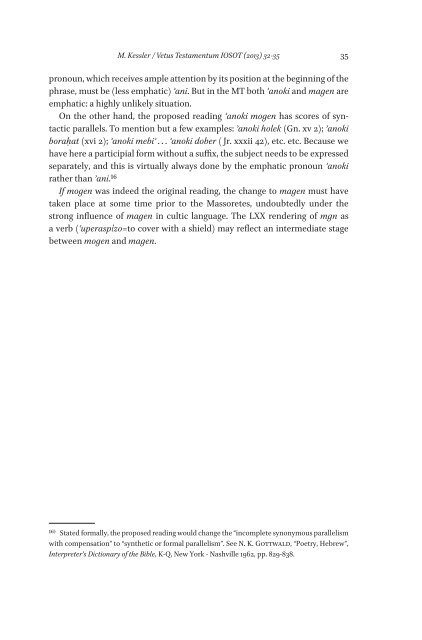Special Issue IOSOT 2013 - Books and Journals
Special Issue IOSOT 2013 - Books and Journals
Special Issue IOSOT 2013 - Books and Journals
You also want an ePaper? Increase the reach of your titles
YUMPU automatically turns print PDFs into web optimized ePapers that Google loves.
M. Kessler / Vetus Testamentum <strong>IOSOT</strong> (<strong>2013</strong>) 32-35 35<br />
pronoun, which receives ample attention by its position at the beginning of the<br />
phrase, must be (less emphatic) ʾani. But in the MT both ʾanoki <strong>and</strong> magen are<br />
emphatic: a highly unlikely situation.<br />
On the other h<strong>and</strong>, the proposed reading ʾanoki mogen has scores of syntactic<br />
parallels. To mention but a few examples: ʾanoki holek (Gn. xv 2); ʾanoki<br />
boraḥat (xvi 2); ʾanoki mebiʾ . . . ʾanoki dober ( Jr. xxxii 42), etc. etc. Because we<br />
have here a participial form without a suffix, the subject needs to be expressed<br />
separately, <strong>and</strong> this is virtually always done by the emphatic pronoun ʾanoki<br />
rather than ʾani.16<br />
If mogen was indeed the original reading, the change to magen must have<br />
taken place at some time prior to the Massoretes, undoubtedly under the<br />
strong influence of magen in cultic language. The LXX rendering of mgn as<br />
a verb (ʿuperaspἰzo=to cover with a shield) may reflect an intermediate stage<br />
between mogen <strong>and</strong> magen.<br />
16) Stated formally, the proposed reading would change the “incomplete synonymous parallelism<br />
with compensation” to “synthetic or formal parallelism”. See N. K. Gottwald, “Poetry, Hebrew”,<br />
Interpreter’s Dictionary of the Bible, K-Q, New York - Nashville 1962, pp. 829-838.








![Am HaSefer [Volk des Buches] - Books and Journals](https://img.yumpu.com/20648352/1/174x260/am-hasefer-volk-des-buches-books-and-journals.jpg?quality=85)







